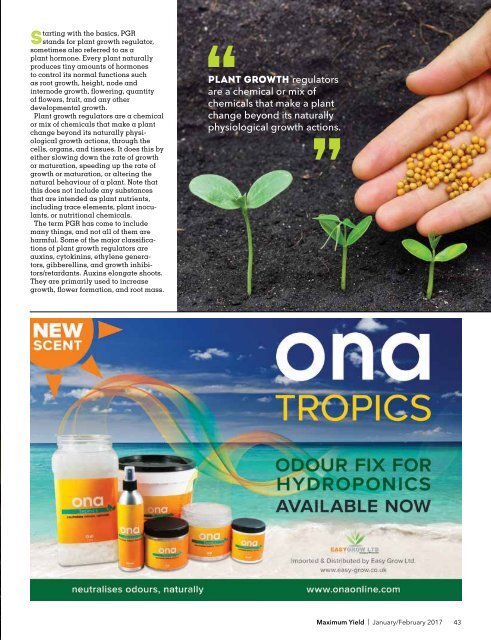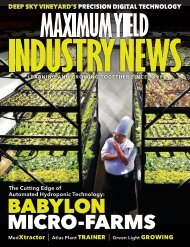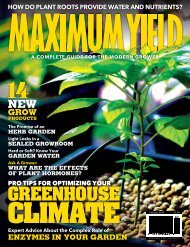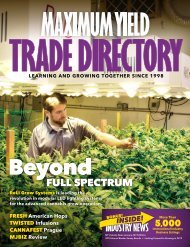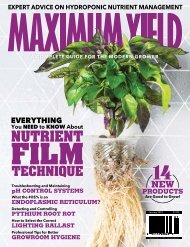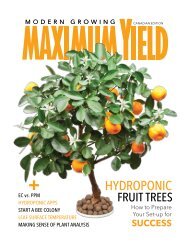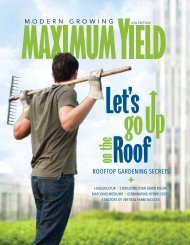Maximum Yield Modern Growing | UK/EU Edition | January/February 2017
The world of indoor growing is expanding at an incredible rate. No longer the alternative to traditional agriculture, hydroponics is being recognised as beneficial for many important reasons. Hydroponics yields require up to 50 per cent less land to grow the same amount of produce, and as the world’s arable lands are diminished from overfarming and climate change, hydroponics takes the pressure off the environment by leaving more land available for wildlife reserves, biospheres, and other protected areas. Drought-ridden areas like California will appreciate the fact hydroponics uses only 10 per cent of the water needed for growing in soil, and far less chemicals and fertilisers-as much as 60 per cent less- are required. By most reports, growing and transporting food around the globe accounts for as much as 30 per cent of all greenhouse gas emissions. With hydroponics, we can grow almost anything right where we live, reducing the need for carbon emissions. This is especially important for people who live in the Far North. More and more, programs are being created to provide fresh produce for those who live in northern communities, reducing the need to ship relatively small amounts of food while providing food security with fresh, inexpensive fruits and vegetables. It is with these shifts in mind that we’ve made some editorial changes in Maximum Yield. As you may have noticed, on our cover we’ve changed ‘indoor gardening’ to ‘modern growing’. As the industry evolves, so are we. Our content will include a wider look at the advancements in the growing world, both indoors and out. As we flip the calendar from 2016 to 2017, we are taking a new perspective on the world of modern growing, and we look forward to bringing these stories to you. We also wish you and your loved ones the very best for 2017. In the meantime, we hope you have as much fun reading this issue as we did putting it together. As always, thanks for reading Maximum Yield and if you have any questions feel free to contact us at editor@maximumyield.com.
The world of indoor growing is expanding at an incredible rate. No longer the alternative to traditional agriculture, hydroponics is being recognised as beneficial for many important reasons. Hydroponics yields require up to 50 per cent less land to grow the same amount of produce, and as the world’s arable lands are diminished from overfarming and climate change, hydroponics takes the pressure off the environment by leaving more land available for wildlife reserves, biospheres, and other protected areas. Drought-ridden areas like California will appreciate the fact hydroponics uses only 10 per cent of the water needed for growing in soil, and far less chemicals and fertilisers-as much as 60 per cent less- are required. By most reports, growing and transporting food around the globe accounts for as much as 30 per cent of all greenhouse gas emissions. With hydroponics, we can grow almost anything right where we live, reducing the need for carbon emissions. This is especially important for people who live in the Far North. More and more, programs are being created to provide fresh produce for those who live in northern communities, reducing the need to ship relatively small amounts of food while providing food security with fresh, inexpensive fruits and vegetables. It is with these shifts in mind that we’ve made some editorial changes in Maximum Yield. As you may have noticed, on our cover we’ve changed ‘indoor gardening’ to ‘modern growing’. As the industry evolves, so are we. Our content will include a wider look at the advancements in the growing world, both indoors and out. As we flip the calendar from 2016 to 2017, we are taking a new perspective on the world of modern growing, and we look forward to bringing these stories to you. We also wish you and your loved ones the very best for 2017. In the meantime, we hope you have as much fun reading this issue as we did putting it together. As always, thanks for reading Maximum Yield and if you have any questions feel free to contact us at editor@maximumyield.com.
Create successful ePaper yourself
Turn your PDF publications into a flip-book with our unique Google optimized e-Paper software.
Starting with the basics, PGR<br />
stands for plant growth regulator,<br />
sometimes also referred to as a<br />
plant hormone. Every plant naturally<br />
produces tiny amounts of hormones<br />
to control its normal functions such<br />
as root growth, height, node and<br />
internode growth, flowering, quantity<br />
of flowers, fruit, and any other<br />
developmental growth.<br />
Plant growth regulators are a chemical<br />
or mix of chemicals that make a plant<br />
change beyond its naturally physiological<br />
growth actions, through the<br />
cells, organs, and tissues. It does this by<br />
either slowing down the rate of growth<br />
or maturation, speeding up the rate of<br />
growth or maturation, or altering the<br />
natural behaviour of a plant. Note that<br />
this does not include any substances<br />
that are intended as plant nutrients,<br />
including trace elements, plant inoculants,<br />
or nutritional chemicals.<br />
The term PGR has come to include<br />
many things, and not all of them are<br />
harmful. Some of the major classifications<br />
of plant growth regulators are<br />
auxins, cytokinins, ethylene generators,<br />
gibberellins, and growth inhibitors/retardants.<br />
Auxins elongate shoots.<br />
They are primarily used to increase<br />
growth, flower formation, and root mass.<br />
Plant growth regulators<br />
are a chemical or mix of<br />
chemicals that make a plant<br />
change beyond its naturally<br />
physiological growth actions.<br />
<strong>Maximum</strong> <strong>Yield</strong> | <strong>January</strong>/<strong>February</strong> <strong>2017</strong><br />
43


